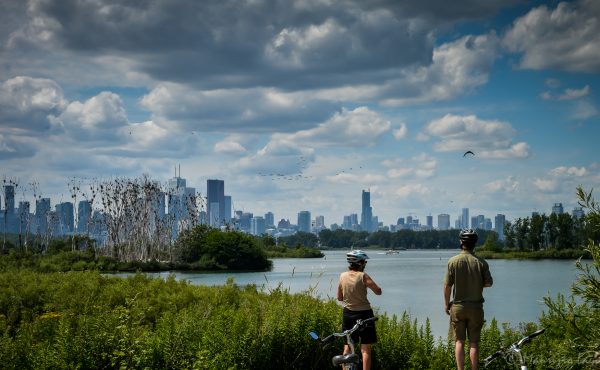 CommunityAIR, the group that helped stop the bridge to the Toronto Island Airport, is still battling hard to keep any kind of commercial airline out of the airport. From their media release yesterday:
CommunityAIR, the group that helped stop the bridge to the Toronto Island Airport, is still battling hard to keep any kind of commercial airline out of the airport. From their media release yesterday:
Bombardier’s Q400 large turboprop does not qualify for use at the Island Airport. This is the plane that Robert Deluce intends to use as the entire initial fleet for Porter Airlines, his new commercial carrier. Porter plans to utilize the Island Airport as its principal hub….
The Q400 is unable to meet this requirement and therefore should not be permitted for commercial use out of the airport. CommunityAIR wrote a letter to this effect on April 11, 2006 addressed to Lawrence Cannon, federal Minister of Transport, Michele McCarthy, Chair of the Toronto Port Authority and David Miller, Mayor of the City of Toronto.
It appears that the Port Authority is intent on violating the Tripartite Agreement. The community expects the Minister of Transport and the City of Toronto to take swift and decisive steps to prohibit the use of the Q400 at the Island Airport in order to uphold the agreement and protect the safety of the many thousands who work, live and play on the waterfront….
Since the Tripartite Agreement was originally struck in 1983, additional significant obstacles, such as the wind power turbine on the CNE grounds and numerous residential towers have sprung up in close proximity to the airport. The seriousness of the bird strike danger at the Island Airport has been further identified — the numerous large waterfront populations of gulls, cormorants, ducks, swans, and geese. As well, the deficiencies of the Island Airport’s runways, taxiways and safety zones have been further detailed.There is currently no commercial air traffic out of the Island Airport. It would be a serious dereliction of duty for the signatories to the Tripartite Agreement to allow high-volume commercial scheduled service to restart at the airport, particularly based on the Q400 aircraft. Instead the money-losing, substandard, unnecessary airport should be shut and the 200-acres converted into a spectacular public amenity that would help kick-start waterfront rejuvenation.




3 comments
this is where i chime in and encourage everyone to take a helicopter ride from the island airport before they shut it down; it is really a spectacular view.
National Helicopter’s Toronto tours are also offered from the helipad on the southwestern tip of Ontario Place.
Let us take a look at some of specifics of the “safety concerns” Community Air has published about the most recent Deluce proposal.
Community Air claims that the Q-400 constitutes a danger to the waterfront, and they cite as evidence that the design for two airports in California and Idaho call for longer runways to accommodate a mixture of aircraft, including the Q-400. This ignores the calculation used in determining the take-off length required for an aircraft, which takes both the weight of the aircraft, and the altitude of the airport normalised for the ambient temperature (called “density altitude”) into account. Since the California airport sits 2000 feet higher than Toronto City Centre, and the Idaho Airport in question sits 5000 feet higher than City Centre, it stands to reason that they require longer runways to accommodate aircraft of a given size.
From there, Community Air’s claims grow more absurd. In a reference to a planning document for Plymouth England, they claim 1161 meters as a “published length” for the main runway of Toronto City Centre Airport, although the Canada Air Pilot, the publication which counts, gives it as 4000 feet or (according to every conversion calculator I have consulted) well over 1200 meters. Then they go on to complain that transport Canada does not consider the runway long enough to accommodate turbojets (probably why the Deluce proposal calls for turbo-prop aircraft).
Community Air then makes a similar series of misleading claims about the capacity of the taxiways, saying that taxiways Charlie, Bravo, and Echo do not meet the minimum recommended width for Q-400 operations. They neglect to note that Echo taxiway goes to runway 15, a permanently closed runway, and Charlie and Bravo allow for intersection operations for small aircraft; the Q-400 operations will use none of these three taxiways.
They also quote a series of warnings on the airport website; warnings which apply to flights operating under visual flight rules (all commercial operations using the Q-400 will take place under instrument flight rules).
On the strength of these and other dubious claims, Community Air attempts to smear the integrity and professionalism of Robert Deluce and Transport Canada’s Ontario Director for Civil Aviation. They do not appear to have much respect for the public’s knowledge of aviation, or our willingness to check the facts. Events over the next few months will tell us whether or not the Toronto public deserves this contempt.